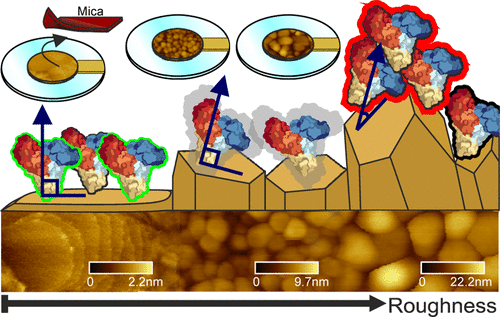Journal: Langmuir 2019, 35(27), 8889-8895.
Authors: Juan A. Rubio-Lara, Frederik Bergler, Simon J. Attwood, J. Michael Edwardson, Mark E. Welland
Abstract: Single-molecule imaging of proteins using atomic force microscopy (AFM) is crucially dependent on protein attachment to ultraflat substrates. The template-stripping (TS) technique, which can be used to create large areas of atomically flat gold, has been used to great effect for this purpose. However, this approach requires an epoxy, which can swell in solution, causing surface roughening and substantially increasing the thickness of any sample, preventing its use on acoustic resonators in liquid. Diffusion bonding techniques should circumvent this problem but cannot be used on samples containing patterned features with mismatched heights because of cracking and poor transfer. Here, we describe a new technique called pressure-forming TS (PTS), which permits an ultraflat (0.35 ± 0.05 nm root-mean-square roughness) layer of gold to be transferred to the surface of a patterned substrate at low temperature and pressure. We demonstrate this technique by modifying a quartz crystal microbalance (QCM) sensor to contain an ultraflat gold surface. Standard QCM chips have substantial roughness, preventing AFM imaging of proteins on the surface after measurement. With our approach, there is no need to run samples in parallel: the modified QCM chip is flat enough to permit high-contrast AFM imaging after adsorption studies have been conducted. The PTS-QCM chips are then used to demonstrate adsorption of bovine serum albumin in comparison to rough QCM chips. The ability to attach thin layers of ultraflat metals to surfaces of heterogeneous nature without epoxy will have many applications in diverse fields where there is a requirement to observe nanoscale phenomena with multiple techniques, including surface and interfacial science, optics, and biosensing.



